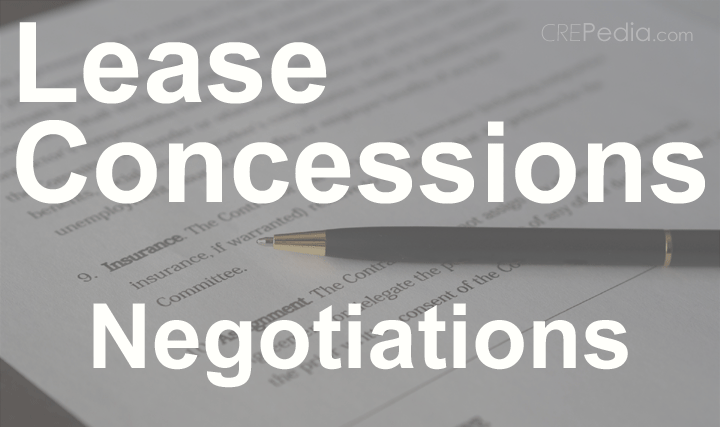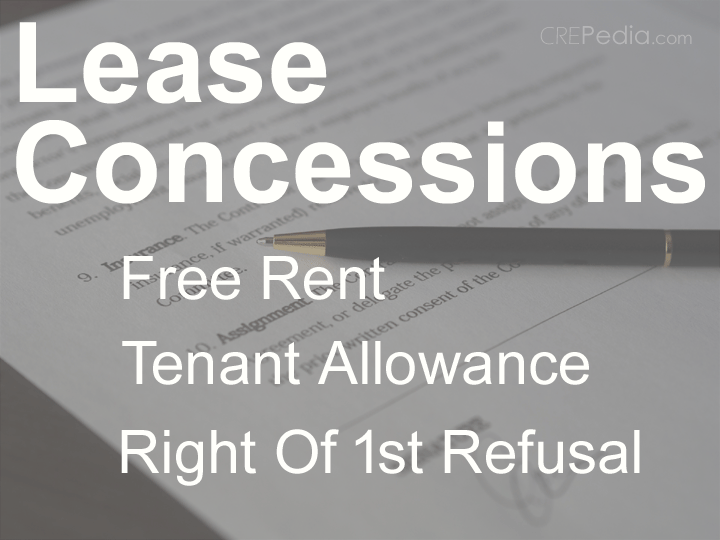What Are Lease Concessions?
Tenant Inducements, or lease concessions, are discounts, incentives, or benefits conceded by a landlord to induce a tenant into a commercial lease agreement. Concessions encompass any special provisions, reductions in rent, expenses, or anything else of value offered by the landlord to entice a potential tenant into a lease.
As part of the negotiation process, concessions are deal points that landlords can use to entice a potential tenant into entering into a new lease. Landlords can also use rent concessions to retain a tenant in a lease renewal or retain a desirable tenant if the tenant is considering a default and the market conditions are working against the landlord.
Lease Concessions, Landlord Concessions, Rent Concessions, Tenant Inducements
In commercial real estate, terminology may vary by region. Different terms may also be used to refer to lease concessions including: landlord concessions, rent concessions, tenant inducements, or simply concessions. These terms are used interchangeably in the context of lease negotiations between landlords and tenants.
Landlord Lease Concessions versus Concession Agreements
It is important to make a distinction in commercial real estate and point out that a concession can also refer to something entirely different. A separate meaning of concession refers to a grant of rights or property by a government, institution, or other entity to do business or conduct a particular activity.
A mining concession would be an example of this type of concession where a government grants the rights to mine minerals or other raw materials in a given area to a company or group of investors. Similarly, a vendor may obtain the right to sell and conduct business at an event such as a fair or concert. These examples of concessions refer to a concession contract, NOT the items a landlord is willing to concede to a prospective tenant while negotiating a lease.

Lease Concessions In Lease Negotiations
Lease concessions arise out of the lease negotiation process between the prospective tenant and landlord. Landlords are in the business of offering commercial space to the marketplace. In return, they have certain expectations in terms of rent and other lease terms they wish to obtain when they conclude a new or renewed lease. The overarching goal of the landlord is to optimize their income and maximize their property's value in exchange for responding to the needs of prospective occupiers.
Conversely, commercial tenants demand space that best accommodates their operational needs, enhances their ability to serve their customers, and optimizes the performance of their business. The particular space requirements of any business can be wide ranging as businesses are diverse and work to differentiate from one another.
Potential tenants may require specific layouts or architectural designs, visibility, parking, or signage. These businesses might be seasonal, or vary in the time required to setup and open. Unforeseen changes in the business or business environment may also be a factor. All these requirements must fall within financial, legal, tax, and operating parameters that will have to be reflected in their lease agreement.
These requirements will establish what concessions may be valuable to the tenant, while providing an understanding of how the lease concession may be structured back into the lease in a way that also works for the landlord.
The Landlord's Perspective
Ideally, the landlord has been advised and has experience in their market. The landlord knows how their property is performing in the marketplace, and whether the property is competitive. This helps them set expectations and establish the rent and lease terms of the space they are offering in the marketplace.
If vacancies are low, the market is strong, the landlord's property is performing well with high quality tenants, and the space is offered at competitive rates and lease terms, the landlord may not feel the need to offer much in terms of concessions.
Conversely, if a property has higher than market vacancies, the property is in need of quality tenants, or the space being offered is out of line with the market, the landlord may be motivated to make significant concessions to attract tenants.
The Tenant's Perspective
Before entering lease negotiations with a landlord, the prospective tenant has likely become familiar with the space or commercial properties available on the market. The tenant is hopefully advised and educated by a commercial real estate broker who has provided insight into the market. The broker may have also provided insight into the landlord's strength and position in the market place.
In addition to their needs and their budget, the prospective tenant should keep in mind what the value of the tenant and the lease is to the landlord. It is important to understand how the tenant will impact the income, the overall value of the property, and other tenants in the property. This can help the tenant anticipate tradeoffs the landlord will want to make in exchange for any concession the tenant would like.
Since the landlord establishes the expectations of the initial rent and lease terms when it lists and markets its property, the door is open for the potential tenant to ask the landlord about concessions. Understanding the perspectives of both sides of the deal helps understand how to make a deal that will work for both landlord and tenant.

Examples Of Lease Concessions And Tenant Inducements
Any benefit a landlord can offer a tenant to discount or defer rent, or accommodate the tenant is a lease concession. Lease concessions may consist of free rent, increased tenant improvement allowances, deferred or reduced lease escalations, signage, parking, lease options, and first rights of refusals.
Free Rent
Free rent is one type of tenant inducement where a landlord offers access and possession of the premises to a tenant without charging rent for one or more specified periods. The way free rent is allocated throughout the lease term is negotiable between landlord and tenant.
The periods for which free rent allocated is depends on many factors including landlord’s and tenant’s strength, market conditions, the type and structure of the lease, the construction requirements, the operational demands of the tenant’s business, and the cash flow, valuation, and financing constraints of the landlord’s property.
There are key stages in which the tenant will likely need access and possession of the commercial space or property. The first period is the time it takes to permit and build out the space which may take several months. Once the build-out is completed, the tenant will need time to move in, install equipment, and setup the business so it is ready to operate. This will be followed by the tenant’s occupation of the premises to operate their business.
The tenant’s preference for taking free rent will depend on several considerations. First, the tenant will likely prefer not to pay rent while the tenant can’t use the property to operate its business. Ideally, this means the tenant would not pay rent while the space is under construction, nor pay during the move-in period. This may be the norm in a given market. Given these considerations, the landlord and tenant will have to establish a start date for the lease.
Once the start date is established, this leaves the tenant and landlord to come to an agreement on how free rent can be allocated throughout the lease term. The tenant may wish to take free rent upfront. However, the tenant may also prefer to take free rent intermittently throughout the lease term.
Whether free rent is taken upfront or intermittently over the lease term, there are tradeoffs for both landlord and tenant. Consequently, it’s important to be aware that the landlord generally recovers “free rent” through the lease in one way or another.
The most consequential impact of free rent to the landlord is the impact upon the value of the property and the income of the property upon which its financing is based. The landlord may want to increase the stated rental rate for the remaining rental periods. Once the free rent period has passed, the landlord can show a higher income that is multiplied into a higher property value. For this reason, free rent in the beginning can be more advantageous than simply lowering the rent throughout the entire lease term.
Tenant Improvement Allowances
Tenant improvement allowances are the monies the landlord will pay to build out a space for the tenant. Landlords may offer a standard tenant allowance in alignment with other competing landlords in the market. However, this allowance may not cover the entire costs of the build-out.
If the tenant is desirable to the landlord and the tenant has a strong negotiation position, the landlord can offer to increase the allowance over and above what the landlord was initially offering. The landlord can either cover the cost, or reimburse the tenant if the tenant is handling the build-out. Additionally, the landlord can build the additional costs back into the rent to recover them.
First Right Of Refusal
A first right of refusal is a lease clause that gives priority to a tenant to lease additional space in the landlord’s property if an offer is made and the tenant can match the terms. A first right of refusal can be used as a tenant inducement because it provides the tenant an opportunity to grow in the building without having to immediately lease the space.
A first right of refusal allows the landlord a chance to continue marketing the space to prospective tenants. The disadvantage is any potential prospect’s offer has a chance of being refused if an existing tenant has a first right of refusal on the space and the tenant can match the offer.